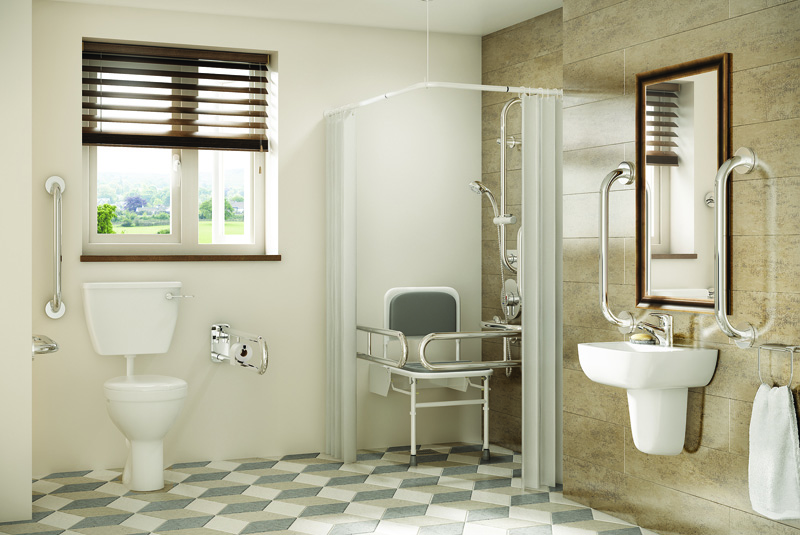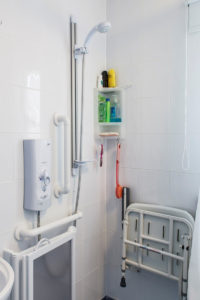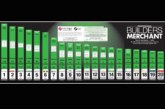
With three generational living becoming increasingly prevalent in today’s world, homeowners are looking for well designed, yet easily accessible bathrooms which cater for the elderly and young alike. PBM’s James Moore looks at this trend, and importantly, what it means for merchants.
As the UK population continues to live longer, the growth in ‘three generation’ homes has become a prominent topic within the sector over recent years. Whilst specific facilities to cater for the needs of more vulnerable, elderly and / or disabled individuals are still available, the market has seen more and more homeowners looking to adapt properties — whether their own or those of younger family members they can move in with — rather than risk losing their valued independence.
A new report, co-sponsored by Mira Showers, focusing on the operation of the Disabled Facilities Grant highlights the value that adaptations to homes can bring to individuals and society. “The accessibility of the home is finally being recognised as important for successful hospital discharge, to enable care to take place at home, and to allow people to live independent lives,” says the report, published by Foundations.
The report has asked suppliers to create more aspirational designs — as opposed to old-fashioned, often more ‘institutional’ aesthetics — to suit modern lifestyles. According to the latest figures, there were 10 million disabled people in England in 2011, with one in 10 adults experiencing mobility problems and around 1.25 million people with significant sight loss. With figures set to rise over the coming years, the need for adaptability and accessibility in modern homes is only set to increase.
 Bathrooms, inevitably, feature as a major focus in all of this. As a place where accidents are perhaps most likely to happen and accessibility is key, merchants must respond to the industry trends, and offer products and design options which suit. Indeed, there are a number of suppliers providing solutions to the issue, as they attempt to combine modern aesthetics with flexible and functional designs — all of which can increase the options available to a merchant’s customers and allow engagement in an ever-expanding market.
Bathrooms, inevitably, feature as a major focus in all of this. As a place where accidents are perhaps most likely to happen and accessibility is key, merchants must respond to the industry trends, and offer products and design options which suit. Indeed, there are a number of suppliers providing solutions to the issue, as they attempt to combine modern aesthetics with flexible and functional designs — all of which can increase the options available to a merchant’s customers and allow engagement in an ever-expanding market.
In respect of showering, the multi-generational bathroom provides three main installation opportunities: wetrooms and/or easy access low trays; non-slip trays — such as Mira Flight Safe — and showers that lend themselves to adaptational living.
Low trays make it easy for young and old to access the shower, while non-slip trays are similarly safer for vulnerable age groups. Digital showers are on-trend at the upper end of the market; yet are also easy to operate if frail of hand. In addition, showers — like Mira Advance Flex — with long hoses and large, colour-contrasted controls are great for wheelchair users or those with impaired vision, while maintaining a desirable contemporary aesthetic that works in any bathroom.
“The accessibility of the home is finally being recognised as important for successful hospital discharge, to enable care to take place at home, and to allow people to live independent lives.”
AKW can lay claim to a long heritage in this corner of the market. The manufacturer has recently been featured on a programme titled Caring Communities, which explores the complex role of care and the initiatives happening in the sector as demand grows exponentially.
Like Mira, the company has focused on an accessible shower unit, which it believes is a vital part to any design encompassing a multitude of generations. The iCare is a stylish electric shower, which can be operated remotely via a control or smartphone app by a care assistant, consequently allowing users to maintain their privacy while benefitting from the latest in modern design and technology. To go alongside this, merchants can benefit from AKW’s range of grab rails to support mobility in the bathroom — providing supplementary, yet necessary additions to base products for the merchant, installer and end user all at once.
 Flush with comfort
Flush with comfort
The toilet is of course another key feature. With a multitude of generations living under one roof, it must be functional, flexible, and well designed to fit in with the rest of the home. Seat heights may have to be slightly higher than the standard units to ensure a comfortable range of movement when in use, whilst handles can be added to provide further stability.
A number of manufacturers produce designs to fit in with these needs. Lecico Bathrooms, for example, has introduced a new collection of comfort height WC pan packs into its Atlas range of ceramics, which are said to be competitively priced to enable growth of the company’s assisted living products range — all dedicated to the issue at hand. The Starck 3 wall-mounted WC from Duravit is another product on offer, featuring a seat position five centimetres higher, as well as working with existing connections — making it ideal for renovation and adaptation projects.
Wash and go
The sink is perhaps not the first area that comes to mind when looking at accessibility, yet it is the most frequently used area of the bathroom. For those less able, it is vital that the washbasin and tap are within easy reach, and that there is the necessary legroom underneath the unit for comfortable use by those in wheelchairs. Duravit has highlighted its flat washbasins, such as the Vero range, as a solution to this problem. Standing at just 165mm high, it is comfortable to use and available in a variety of widths to save valuable space.
There are lots of things to think about for installers and homeowners when designing an accessible bathroom. Merchants should look to a number of dedicated suppliers and an increasing number of ‘mainstream’ manufacturers offering solutions which aim to cater for this expanding and important market. By doing so, stockists can offer a greater range of products to their customers, simultaneously growing their own business with base units and supplementary design features — all resulting in a boost in sales and customer growth.









